1998 CHEVROLET ASTRO child restraint
[x] Cancel search: child restraintPage 7 of 414
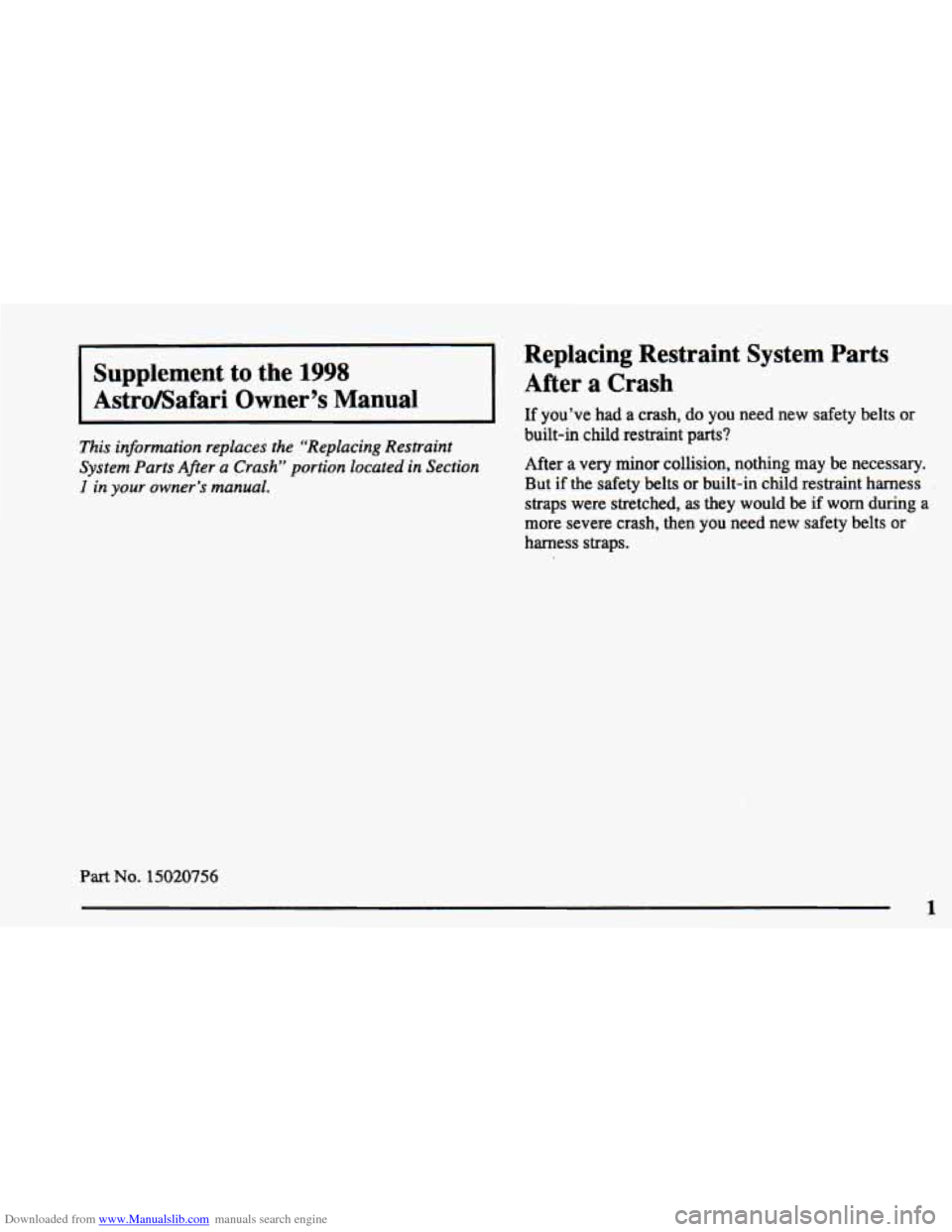
Downloaded from www.Manualslib.com manuals search engine Supplement t
AstroBafari Uwnd
Replacing Restraint System Parts After a Crash
‘0 the 1998
zr’s Manual If you’ve had a.crash, do you need new safety belts or ~~~~
built-in child restraint parts? This information replaces the “Replacing Restraint
System Parts After a Crash” portion located in Section
After a very minor collision, nothing may be necessary.
1 in your owner’s manual. But if the safety belts or built-in child restraint harness
straps were stretched, as they would be if worn during a
more severe crash, then
you need new safety belts or
harness straps.
Part No. 15020756
1
Page 8 of 414
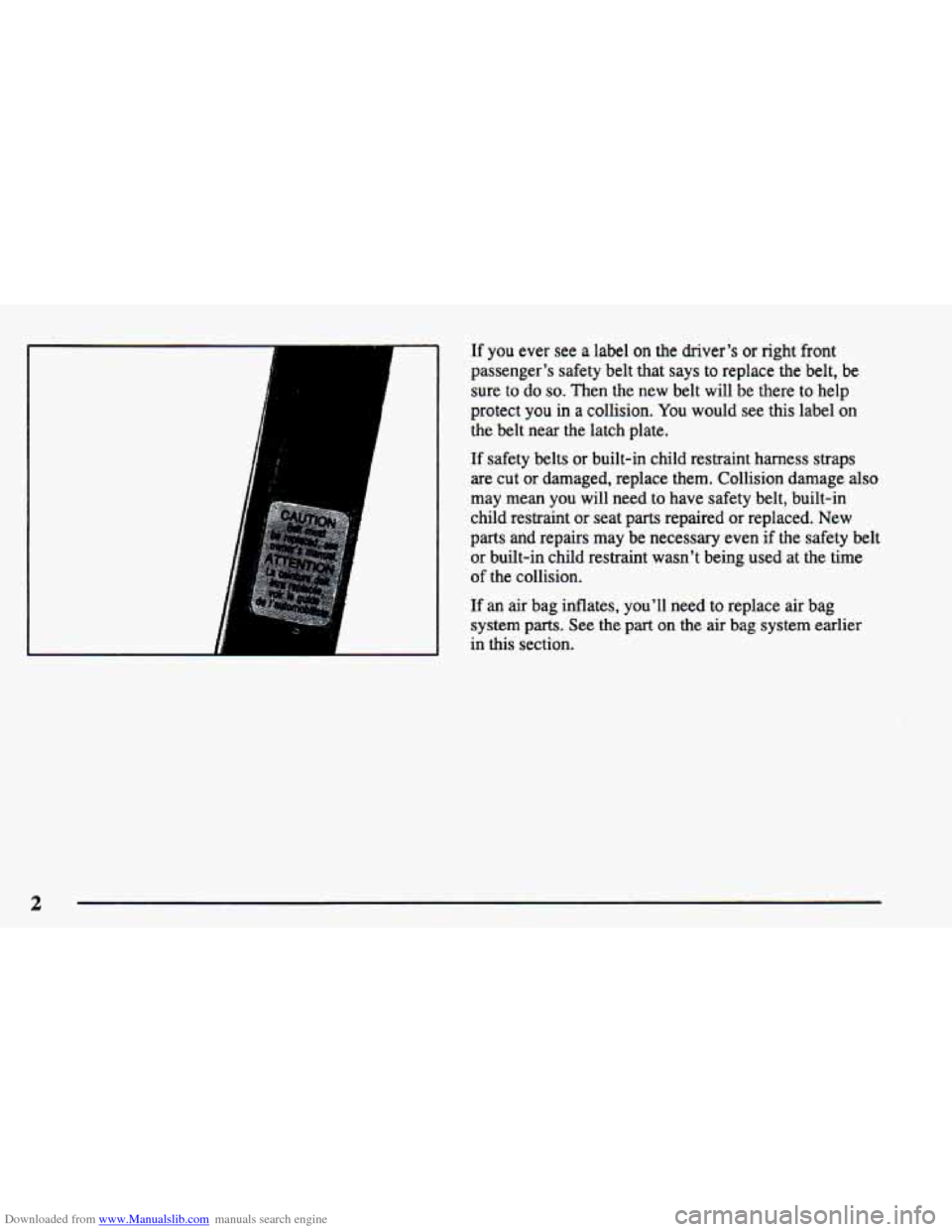
Downloaded from www.Manualslib.com manuals search engine If you ever see a label on the drrver’s or right front
passenger’s safety belt that says to replace
the belt, be
sure
to do so. Then the new belt will be there to help
protect
you in a collision. You would see this label on
the belt near the latch plate.
If safety belts or built-in child restraint harness straps
are cut or damaged, replace them. Collision damage also
may mean you will need to have safety belt, built-in
child restraint or seat parts repaired
or replaced. New
parts and repairs may be necessary even if the safety belt
or built-in child restraint wasn’t being used at the time
of the collision.
If an air bag inflates, you’ll need to replace air bag
system parts. See
the part on the air bag system earlier
in this section.
2
Page 15 of 414

Downloaded from www.Manualslib.com manuals search engine Section 1 Seats and Restraint Systems
Here you’ll find information about the seats in your vehicle and how to use your safety belts properly. You can also
learn about some things you should
not do with air bags and safety belts.
1-2
1-12 1-17
1-18
1-18 1-25
1-26
1-26
1-32 Seats
and Seat Controls
Safety Belts: They’re for Everyone
Here Are Questions Questions Many People
Ask About Safety Belts
-- and the Answers
How to Wear Safety Belts Properly
Driver Position
Safety Belt Use During Pregnancy
Right Front Passenger Position
Air Bag System
Rear Seat Passengers 1-35
1-38 1-39
1-44
1-52
1-65
1-68
1-68
1-68 Rear
Safety Belt Comfort Guides for
Children and Small Adults
Center Passenger Position (Bench Seat)
Children
Built-in Child Restraint (Option)
Child Restraints
Larger Children
Safety Belt Extender
Checking Your Restraint Systems
Replacing Restraint System Parts After
a Crash
Page 22 of 414
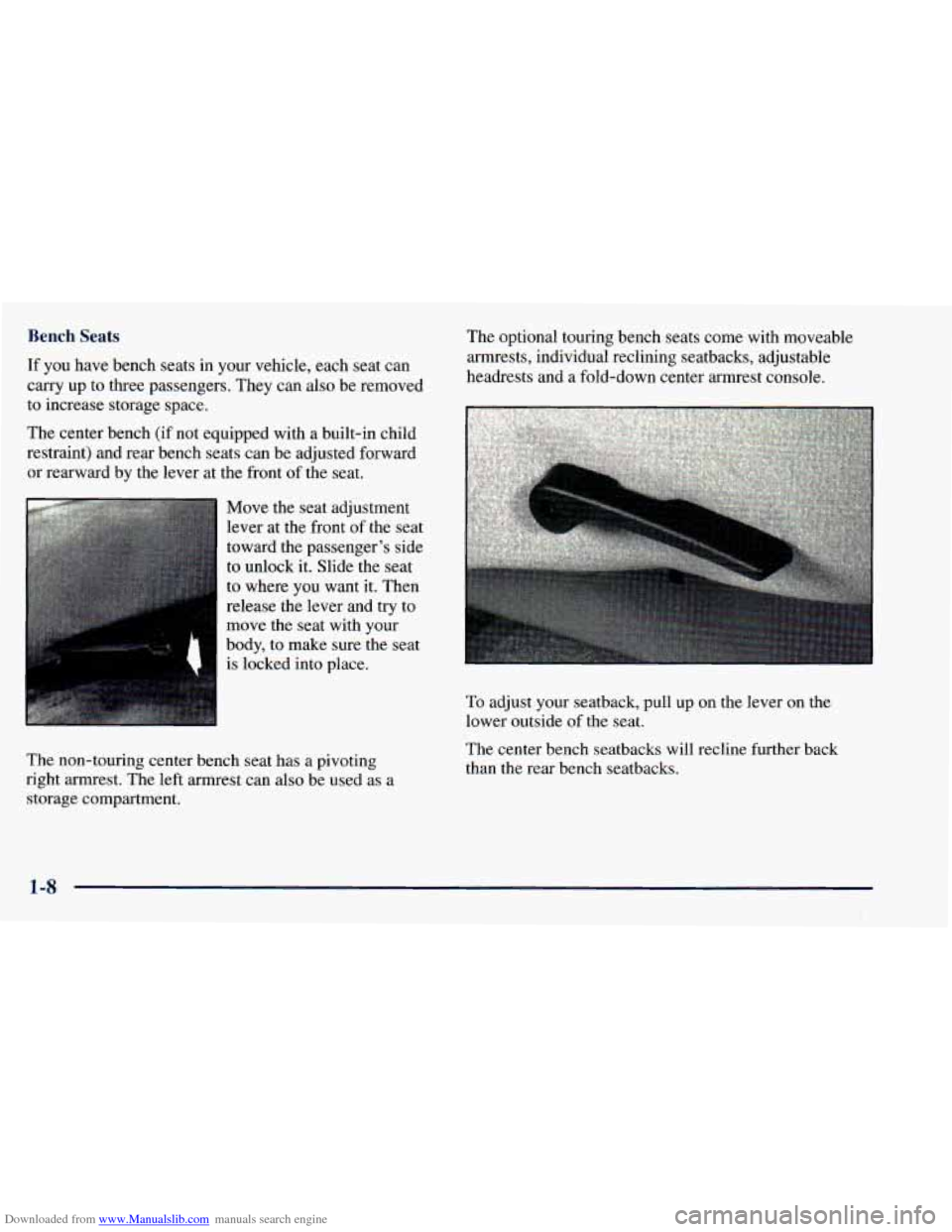
Downloaded from www.Manualslib.com manuals search engine Bench Seats
If you have bench seats in your vehicle, each seat can
carry up to three passengers. They can also be removed
to increase storage space.
The center bench (if not equipped with a built-in child
restraint) and rear bench seats can be adjusted forward
or rearward by the lever at the front of the seat.
Move the seat adjustment
lever at the front
of the seat
toward the passenger’s side
to unlock it. Slide the seat
to where you want it. Then
release the lever and try to
move the seat with
your
body, to make sure the seat
is locked into place. The
optional touring bench seats come with moveable
armrests, individual reclining seatbacks, adjustable
headrests and
a fold-down center armrest console.
The non-touring center bench seat has a pivoting
right armrest. The left armrest can also be used as a
storage compartment. To
adjust your seatback, pull up on the lever on the
lower outside of the seat.
The center bench seatbacks will recline further back
than the rear bench seatbacks.
1-8
Page 32 of 414

Downloaded from www.Manualslib.com manuals search engine How to Wear Safety Belts Properly
Adults
This part is only for people of adult size.
Be aware that there are special things to know about
safety belts and children. And there are different rules
for smaller children and babies. If
a child will be
riding in your vehicle, see the part of this manual
called “Children.” Follow those rules for everyone’s
protection.
First, you’ll want
to know which restraint systems
your vehicle has.
We’ll start with the driver position.
Driver Position
This part describes the driver’s restraint system.
Lap-Shoulder Belt
The driver has a lap-shoulder belt. Here’s how to wear
it properly.
1. Close and lock the door.
2. Adjust the seat (to see how, see “Seats” in the Index)
so you can sit up straight.
3. Pick up the latch plate and pull the belt across you.
4. Push the latch plate into the buckle until it clicks.
Don’t
let it get twisted.
Pull up
on the latch plate to make sure it is secure.
If the belt isn’t long enough, see “Safety Belt
Extender” at the end
of this section.
Make sure the release button
on the buckle is
positioned
so you would be able to unbuckle the
safety belt quickly if you ever had to.
1-18
Page 40 of 414
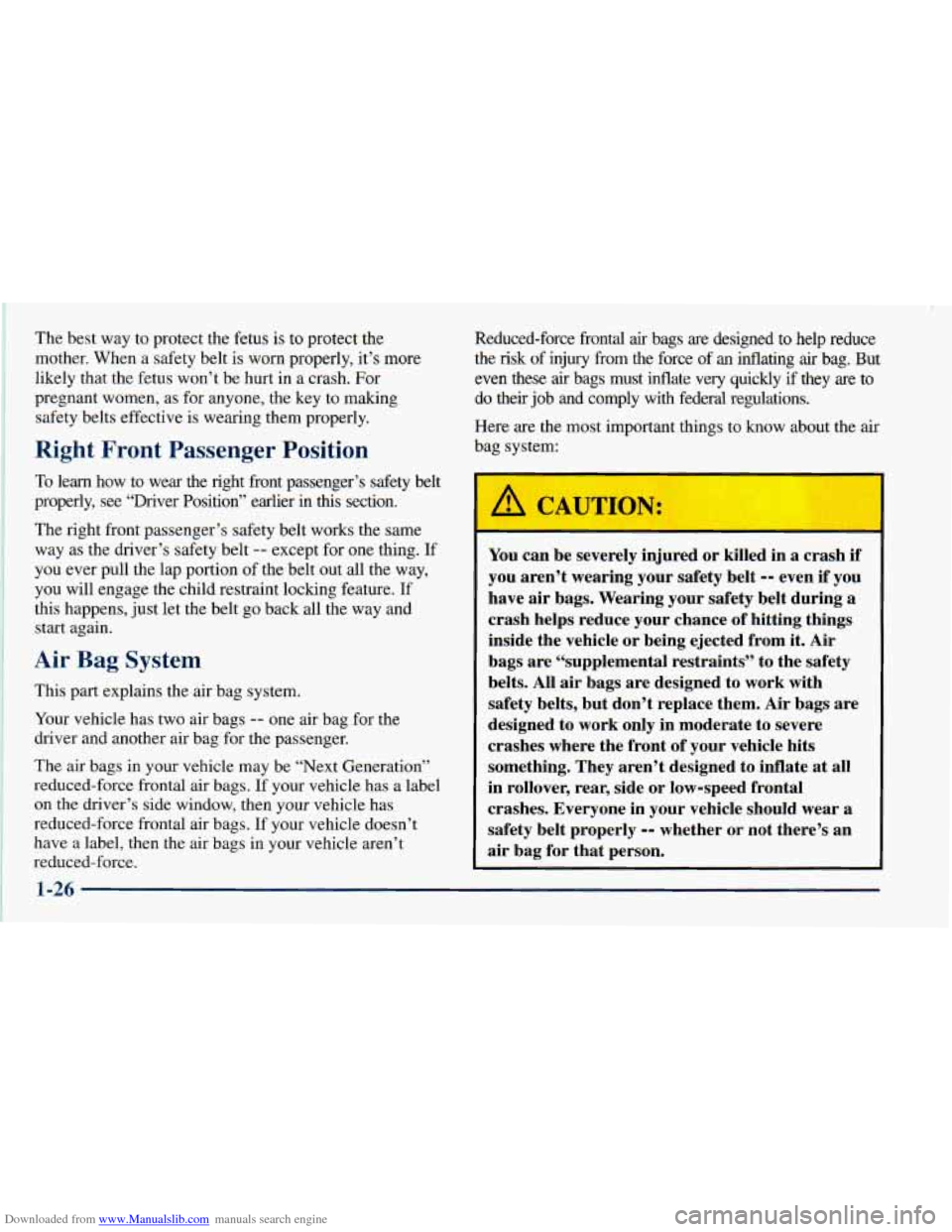
Downloaded from www.Manualslib.com manuals search engine The best way to protect the fetus is to protect the
mother. When a safety belt is worn properly, it’s more
likely that the fetus won’t be hurt in a crash. For
pregnant women, as for anyone, the key to making
safety belts effective is wearing them properly.
Right Front Passenger Position
To learn how to wear the right front passenger’s safety belt
properly, see “Driver Position” earlier in
this section.
The right front passenger’s safety belt works the same
way as the driver’s safety belt
-- except for one thing. If
you ever pull the lap portion of the belt out all the way,
you will engage the child restraint locking feature. If
this happens, just let the belt
go back all the way and
start again.
Air Bag System
This part explains the air bag system.
Your vehicle has two air bags
-- one air bag for the
driver and another air bag for the passenger.
The air bags in your vehicle may be “Next Generation”
reduced-force frontal air bags.
If your vehicle has a label
on the driver’s side window, then your vehicle has
reduced-force frontal air bags. If your vehicle doesn’t
have a label, then the air bags in your vehicle aren’t
reduced-force. Reduced-force frontal
air bags are designed to help reduce
the risk of injury
from the force of an inflating air bag. But
even these
air bags must inflate very quickly if they are to
do their job and comply with federal regulations.
Here are the most important things to know about the air
bag system:
‘ 3 CAUTION:
-
You can be severely injured or killed in a crash if
you aren’t wearing your safety belt -- even if you
have air bags. Wearing your safety belt during
a
crash helps reduce your chance of hitting things
inside the vehicle or being ejected from
it. Air
bags are “supplemental restraints’’ to the safety
belts. All air bags are designed to work with
safety belts, but don’t replace them. Air bags are
designed to work only in moderate to severe
crashes where the front of your vehicle hits
something. They aren’t designed to inflate
at all
in rollover, rear, side or low-speed frontal
crashes. Everyone in your vehicle should wear a
safety belt properly
-- whether or not there’s an
air bag for that person.
1-26
Page 41 of 414

Downloaded from www.Manualslib.com manuals search engine i
I
1 CAUTION:
Air bags inflate with great force, faster than the
blink of an eye. If you’re too close to an inflating
air bag, it could seriously injure you. Safety belts
help keep you in position before and during a
crash. Always wear your safety belt, even with
air
bags. The driver should sit as far back as possible
while still maintaining control of the vehicle.
c
i
A CAUTION:
Children who are up against, or very close to, an
air bag when
it inflates can be seriously injured
or killed. This is true even if your vehicle has
reduced-force frontal
air bags. Air bags plus
lap-shoulder belts offer the best protection for
adults, but not for young children and infants.
Neither the vehicle’s safety belt system nor its air
CAUTION: (Continued)
I CAUTION: (Continued)
bag system is designed for them. Young children
and infants need the protection that
a child
restraint system can provide. Always secure
children properly in your vehicle.
To read how,
see the part of this manual called “Children” and
see the caution labels on the sunvisors and the
right front passenger’s safety belt.
There is an air bag
readiness light on the
instrument panel, which
BAG
shows AIRBAG.
The system checks the air bag electrical system for
malfunctions. The light tells you
if there is an electrical
problem. See “Air Bag Readiness Light” in the Index
for more information.
1-27
Page 49 of 414
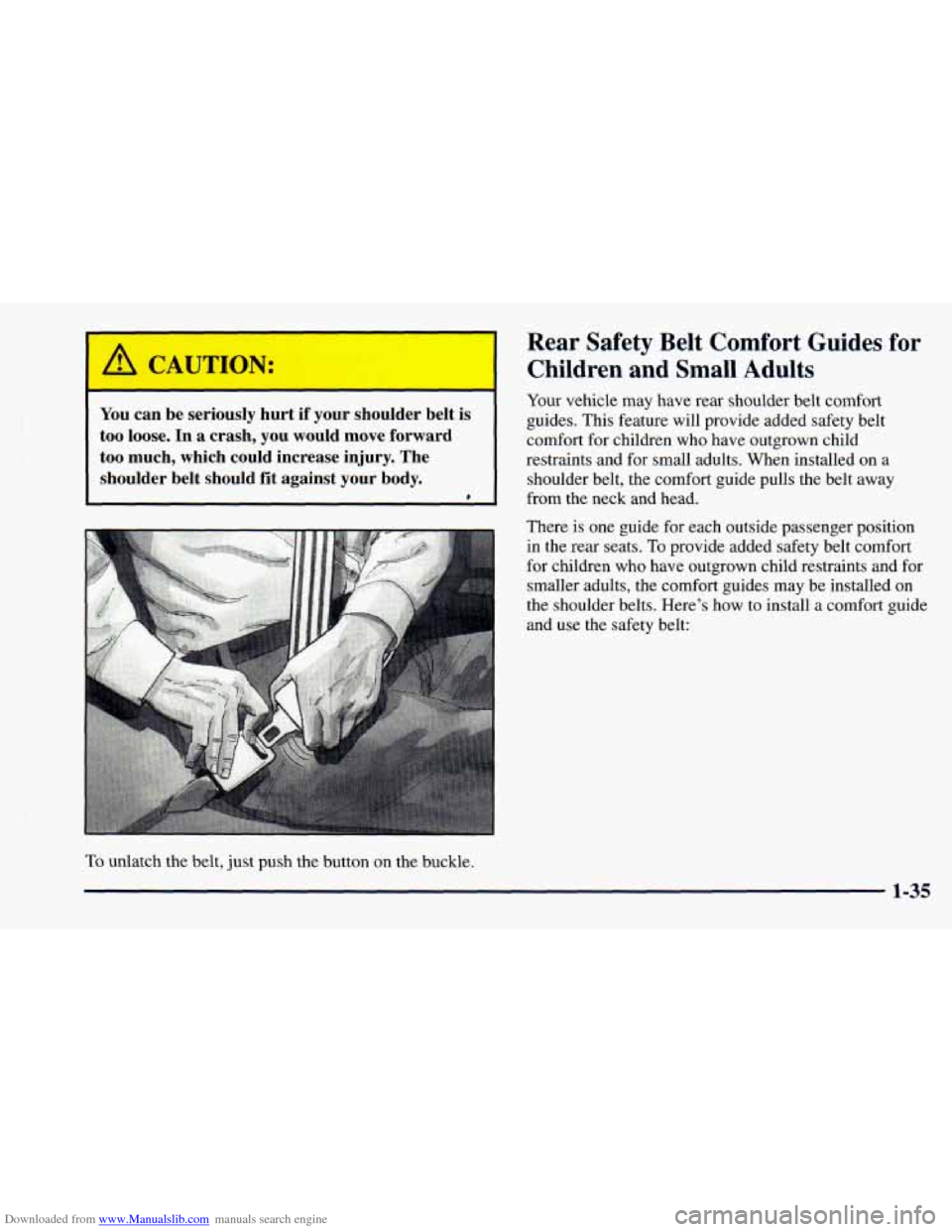
Downloaded from www.Manualslib.com manuals search engine 1 A CAUTION:
r
You can be seriously hurt if your shoulder belt is
too loose. In a crash, you would move forward
too much, which could increase injury. The
shoulder belt should fit against your body.
1
To unlatch the belt, just push the button on the buckle.
Rear Safety Belt Comfort Guides for
Children and Small Adults
Your vehicle may have rear shoulder belt comfort
guides. This feature will provide added safety belt
comfort for children who have outgrown child
restraints and for small adults. When installed on a
shoulder belt, the comfort guide pulls the belt away
from the neck and head.
There
is one guide for each outside passenger position
in the rear seats.
To provide added safety belt comfort
for children who have outgrown child restraints and for
smaller adults, the comfort guides may be installed on
the shoulder belts. Here's how to install a comfort guide
and use the safety belt:
1-35